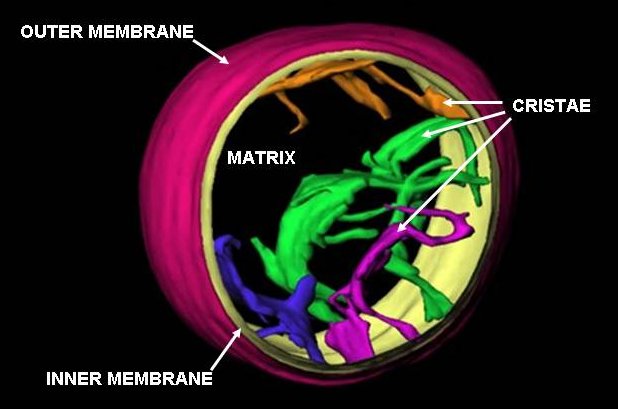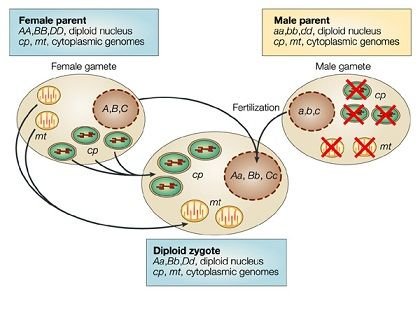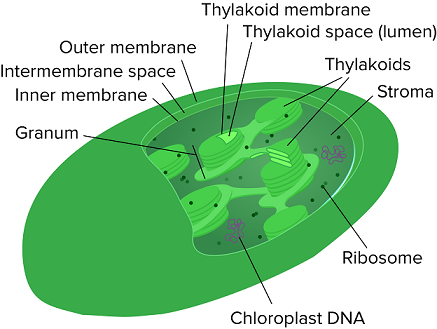Understanding the basics of cytoplasmic/extra-chromosomal inheritance

Good day everyone. Before proceeding to today's discussion, I want to thank every member of this community for their continuous support for my posts. My sincere gratitude goes to steemSTEM and stemng management for the great job they have been doing for the STEM community and for steemit in general. You guys are simply one of the best around.
For some time now, I have been discussing how traits/characters are inherited across generations. The complex processes involved in the mechanisms of trait inheritance in biological organisms have been broken down and simplified to the best of my knowledge and ability. From segregation, independent assortment, codominance, incomplete dominance, epistasis, pleiotropy and eventually to cytoplasmic inheritance. I promised to elaborate more on the latter in my last post which can be found here. Other posts that serve as build up to today's discussion include;
- How are traits inherited across generations?
- How trraits are inherited across generations #2
- How traits are inherited across generations #3
In high school study of cell and cell organelles, what we were made to know was that the nucleus is the organelle that stores genetic information and controls every other activity of the cell. Moving on to the higher institution and I got a new knowledge that some other organelles like chloroplast and mitochondrion actually have their own genetic information which is quite independent of that of the cell. The presence of independent genetic information and ribosome mean the organelles may have the ability to survive as an independent organism. Little wonder that both organelles have been hypothesized to have evolved by endosymbiosis.
Cytoplasmic genes/traits
The inheritance patterns of some attributes of mitochondria and chloroplasts led classical geneticists to infer that the inheritance of these traits are not conditioned by nuclear genes, that is the genes that are located in the nucleus. It was later shown that mitochondria and chloroplasts contain Deoxyribonucleic acid which specify their genetic information. These genes are generally referred to as cytogenes or cytoplasmic genes.
One of the fundamental properties of cytoplasmic genes is that there is a preferential transmission of the maternal cytogenes to the offspring. Nuclear genes can and do sometimes exercise direct or indirect influence on the cytogenes. Because of the uniparental transmission property, the cytogenes are prone to mutation but genetic recombination is greatly reduced and is generally unknown as far as higher plants are concerned.
Up till date, inheritance of characteristics associated with chroloplats provide examples of cytoplasmic inheritance that have been extensively studied. The only well known cytogenes due to mitochondria DNA are the petite mutations in yeasts. The most studied of the cytoplasmic inheritance traits is variegation of leaves or stems as found in ice plant, acalypha and croton. A variegated leaf or stem has patches of green, white and/or brown or red. Only the green parts can undertake photosynthesis however. If the ova from a variegated plant are pollinated with pollen from a green plant, all the offsprings become variegated. However, when the pollen from a variegated plant pollinates the ova of a green plant, all the offsprings are green.
The pattern shown in the study above is similar in all cytogenes studied in higher plants, and this led to the conclusion that the paternal cytogenes are not transmitted because there is little or no cytoplasm associated with the paternal nucleus that participates in fertilization and hence, no paternal cytogenes are carried to the zygote. This is probably true in higher plants and also in animals that produce sperms.
An American scientist, Ruth Sager found that in the alga chlamydomonas, where two isogametes of different mating types may fuse to produce a zygote, the paternal cytogenes are excluded during the meiotic division stages that follow zygote formation, so that the resulting tetrads carry only the maternal cytogenes. In some cases, exception occur when recombination takes place during meiosis. In this case, the process which normall excludes the paternal cytogenes is inhibited, a process that might be due to mutation.
Generally, segregation of cytogenes to daughter cells cay be affected by rapid cell division in which case there is uneven distribution of cytogenes. This can lead to local variations in the pattern of inheritance of some organisms. For example, the budding cell of a branch on a variegated plant may contain predominantly mutant chloroplasts during mitosis, giving rise to an almost white branch which of course is supported by flowers manufactured from the other parts of the plant.
Other example of extrachromosomal inheritance
Sterile cytoplasm has been discovered to be present in plants such as maize, tomatoes and onions. A sterile cytoplasm is one that renders the male pollen ineffective, a phenomenon known as male sterility in plants. Since their pistilate/female parts are functional, such plants can be fertilized by pollen from fertile plants. However, this invariably result in sterile progenies.

Such a process can be exploited to perpetuate male sterility line. Sterile cytoplasm has also been exploited to naturally emasculate plants in the production of hybrid seeds. This eliminates the cost of artificially removing pollen and hand pollination. Hybrid seeds are usually produced because they outyield non-hybrids and produce uniform progeny.
Summary
Character or trait inheritance in living organisms sometimes trascends the nulear genes. Organelles like mitochondrion and chloroplast in eukaryotic organisms have their own genetic information which is quite independent from the cell's information. A lot of trait inheritance has been linked to information in such organelles and it actually form the basis of some well known genetic processes in plants and in humans.
Thank you for reading.
References
- nature: Inheritance of cytoplasmic and nuclear genes
- academic.oup
- National Library of Medicine: Cytoplasmic genetic variation and extensive cytonuclear interactions influence natural variation in the metabolome
- agriinfo.in: Male Sterility
- wiley online library: Historical perspective on Chlamydomonas as a model for basic research: 1950–1970
- science direct: Genetic Analysis of Chloroplast Dna in Chlamydomonas




Being A SteemStem Member
Congratulations @hadji! You have completed some achievement on Steemit and have been rewarded with new badge(s) :
Click on any badge to view your own Board of Honor on SteemitBoard.
For more information about SteemitBoard, click here
If you no longer want to receive notifications, reply to this comment with the word
STOPNice article...😊
Are these cytoplasmic inherited traits are dependent on the parents...?
thanks for reading. The inheritance of such traits are mostly dependent on the mother
Hey, great article, I didn't know some of these :) Keep up the good work!